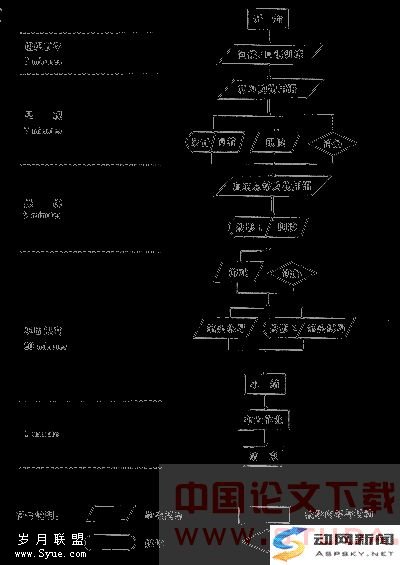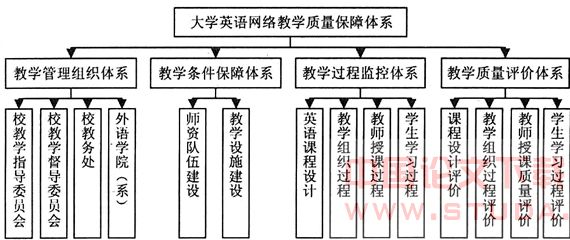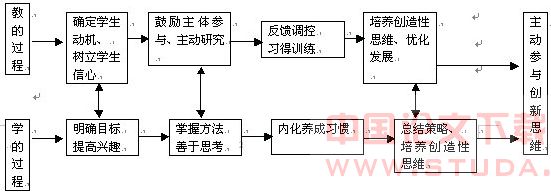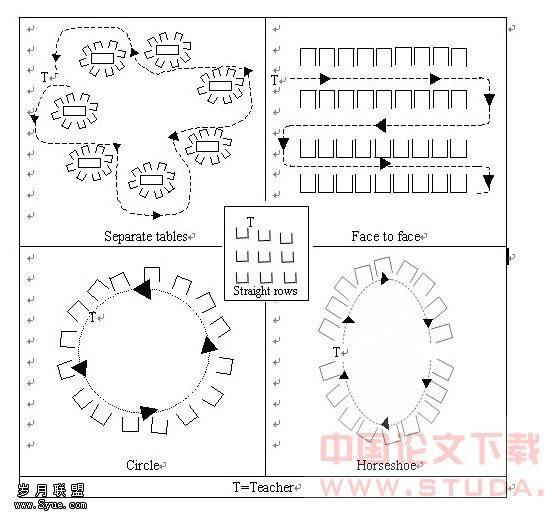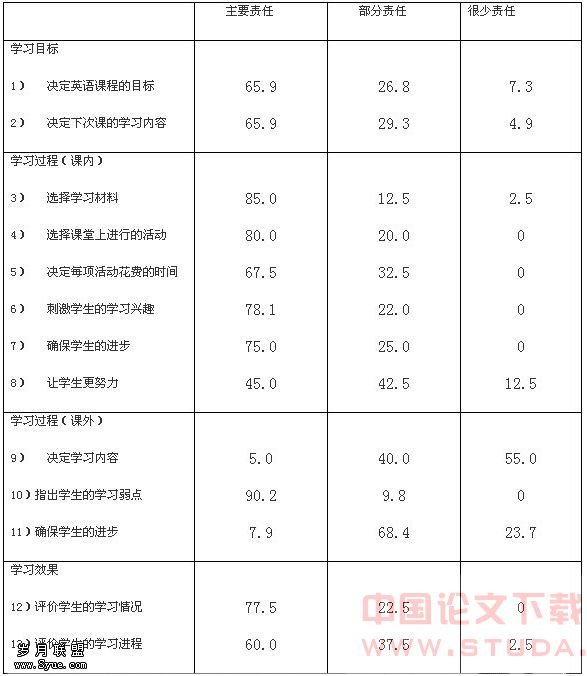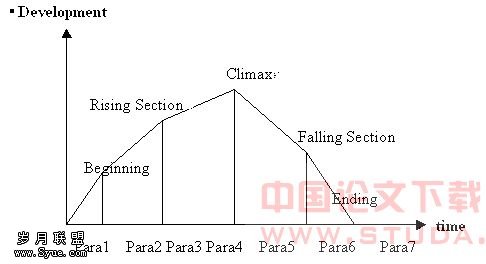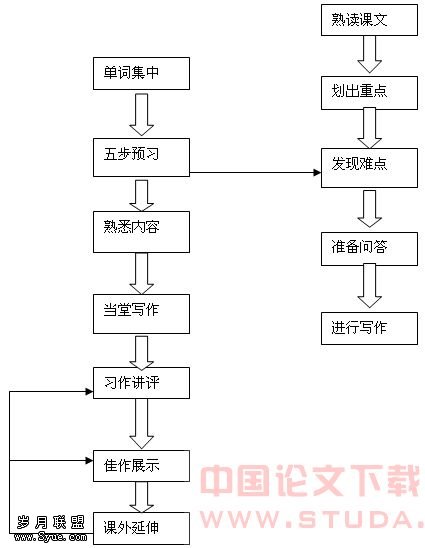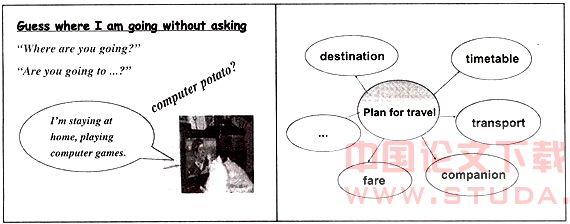图式理论在低年级大学生英语阅读理解中的应用
[Abstract] Reading plays an inestimable part in our study. To learn reading, to become an expert at reading, to improve reading quality, a reader should learn how to use the three schemas of Schema Theory: formal schema, linguistic schema and content schema.
This article introduces formal schema from two aspects: textural style and transitional words. And for linguistic schema, the most important thing is the meaning of vocabulary. The article emphasizes using context clues and word parts to guess the meaning. While for content schema, reader should try to activate his previous background knowledge and personal prior experience. This article puts forward two methods: prediction and association.
In order to understand an English reading perfectly, readers should also use their critical thinking to evaluate the text and finally form their own opinions.
[Key Words] formal schema, linguistic schema, content schema, critical thinking
【摘 要】阅读在我们的学习中占据着不可估量的重要地位. 为了学好阅读,成为阅读方面的能手, 并改善阅读质量, 读者应该学习如何运用图式理论的三个图式,即形式图式,语言图式和内容图式.
本篇从两个方面建立对英语阅读的形式图式,即文体和过渡词. 对于语言图式,最重要的部分是词义. 本文着重运用上下文及构词法来推测词义.而在内容图式中,读者应尽可能地激活背景知识及个人过去的经历.为此目的,文章提出了两个方法:预测和联想.
为了能圆满地完成英语阅读, 除了运用三种图式,还要求读者以自己的批判性思维,对英语阅读做出评价,形成自己的观点.
【关键词】形式图式,语言图式, 内容图式, 批判性思维
1. Introduction
The reading demanded in college is different from the reading in high school or on the job or for recreation. College textbooks contain many new words or words used in a way that is different, perhaps,from the way you might use them in everyday language. Every sentence in a college text looks important and may be important. You know you can’t learn everything in the book, but how do you decide what is absolutely necessary or essential?
Here is a situation that might sound familiar to you. You have been reading and concentrating on the textbook. You get to the end of the section or the chapter you are reading, and you say, “Well, I read it, but I’m sure I didn’t understand it.” In this case you have not comprehended what you have read. You may have looked at every word on the page and you may have ever understood each word. But at the end of the page you have to admit that you did not understand whatever it was that all those words added up to.
2. Schema Theory
Schema was first put forward by German philosopher Kant. “All human beings possess categorical rules or scripts that they use to interpret the world. New information is processed according to how it fits into these rules, called schema” [1] German psychologist Burtlett used and developed the concept of schema. According to Rumelhart, “Schema theory is a theory about men’s knowledge, a theory of the mental representation of information stored in memory, which attempts to account for the way information is comprehended and how new information is learned.”[2] Schema Theory, on the formation of previous knowledge in one’s memory and the application of it in higher understanding, is extremely useful to reading comprehension. If a reader can’t understand a text correctly, there are at least three reasons following:
1 The reader may not have the suitable schema to the text. In this case, the reader is unable to understand the text.
2 The reader has the suitable schema to the text, but the clues the author provides in the text could not enable the reader to activate the schema. In the case, the reader is also unable to understand the text. If the author could provide the reader more hints, the reader may understand the text better.
3 The reader may find some explanation of the text, but this kind of explanation is not the author’s. In the case, the reader may “understand” the text, but he would misunderstand the author.
According to the Schema theory, “reading comprehension actually is the process of filling new information into the suitable schema to embody the schema, and the filling-in content can be the directly understanding or the concluded new information. The whole reading process is carried under the instruction of schema, is the process of activation and building the suitable schema and then filling in new information. When all the important blanks were filled with the information, the text is understood perfectly. Wilson & J.R.Anderson ever had a research on the Schema theory. The research shows the dependable way to improve one’s reading ability is to provide reading advance organizers, that is to provide the schema frame for readers, especially when the contents of reading materials are difficult and the language are obscurity. ” [3]
And first, we should know category of the schema. There are three schemas: formal schema, linguistic schema and content schema. Any change of the schema would influence the result of reading comprehension; meanwhile, the shortage of one schema could be supplied by other schemas.
3. Three Schemas
3.1 Formal Schema
Formal Schema, which is usually called textual schema, means the textual organizing pattern or rhetoric structure. It contains knowledge of different textual style and the understanding of texts using different style, linguistic, structure, glossary and grammar. There are many kinds of textual genres, such as literature, history, political science, psychology, ads, news, etc. There are many kinds of textual style: narration, explanation, argumentation, prose and so on. There are many kinds of structures: comparison and contrast, chronological order (working through passages that start at the beginning and finish at the end of a sequence of events), cause and effect (the relationship between action and reaction), order of importance (using the order in the writing to determine what is most important to the author) and of course, a text could be finished by using all the above structures.
Any author who plans to write an essay would surely consider two factors: content and result. How to arrange and organize the content by certain structure and logic? For example, the political essay is usually compared, and the news usually described, and the history usually the practiced. That is to say, every different essay has its own character and frame. The understanding of it is the foundation of Formal schema. In the process of reading, using the schema which suits to the text, quickening the organization and memory of the information could improve the reading ability. So if you want to understand a text, you should try to find out what kind of structure the text use. There are two ways to find out the type of structure.
3.1.1 Textual style
Let’s look at the passage: Writing Between the Lines in Unit4, A NEW ENGLISH COURSE Book 4, which was published by Shanghai Foreign Language Teaching Press. First, try to understand which textual style it uses. Second try to know the organizing structure and the last one is to the rhetorical structure. From the first paragraph you could easily know that this article is a typical piece of argumentation. The writer makes his intention plain at the very beginning to argue that writing between the lines is an efficient way of reading. He puts forward his argument directly-----“Unless you write between the lines, you are not likely to do the most efficient kind of reading.”[4] Then as everyone knows that argumentative writing usually has three parts---- the introduction, the body, and the conclusion. So has this article. And activating the three parts is activating you schema of the organizing structure of argumentation. At last come to the rhetorical structure of each part. And now try to cast back you memory, activate your schema, if you want to support your idea, what would you do? Usually cite examples, use chart and diagram, appeal to common knowledge, make comparison or contrast and so on. And if citing examples, what examples would you cite? And what examples would the author cite…In this activating process, try to modify you schema step by step, and set up the suitable schema at last.
3.1.2 Transitional words (Linking words)
Look at the following example:
“This year’s employee award ceremony was a tremendous success. The first award was given to Carlos Fe for Perfect Attendance. The second award, for Most Dedicated Employee, went to Jennifer Steele. Then our president, Martin Lucas, interrupted the awards ceremony to announce that he and his wife were having a baby. When he finished, everyone stood up for a congratulatory toast. Afterward, the third award was given to Karen Hunt for Most Inspiring Employee. Finally, President Lucas ended the ceremony by giving everyone a bonus check for $100.” [5]
This paragraph uses the chronological order to tell what happened at the ceremony from the beginning to the end, but how to come to this conclusion? You tell by the order of the sentences themselves---first things first, last things last. And you can also tell by the use of transitional words and phrases: first, second, then, when, afterward, third, finally which signal a shift from one idea to the next. Besides the words expressing time, there are also other words.
“(i). Words expressing the relation of cause and effect: because, since, as, because of, due to, owing to, consequently, therefore, so, as a result, thus, for this reason, lead to, cause, result in, etc
(ii). Words expressing comparison and contrast: both, similar, like, alike, same, in a similar way, difference, however, although but, instead, different, while, unlike, on the other hand, nevertheless, on the contrary, etc
(iii). Words expressing linking or appending of definition: besides, in additions, as well as, moreover, further more, etc
(iv). Words expressing category: fall into, be divided into, be subdivided into, be separated into, be classed into, classes, groups, kind, types, category, etc
(v). Words expressing definition: be, be defined as, be known as, be called, mean, refer to, involve, deal with, be concerned with, etc
(vi). Words expressing of citing examples: like, such as, for example, for instance, be illustrated of, as illustrated by, an example of, etc” [6]
How do the students activate the two ways mentioned above to do the reading comprehension? Now look at the following example of reading comprehension, TEM 4, 2002, TEXT B.
“The ‘standard of living’ of any country means the average person’s share of the goods and services which the country produces. A country’s standard of living, therefore, depends first and foremost on its capacity to produce wealth. ‘Wealth’ in this sense is not money, for we do not live on money but on things that money can buy: ‘goods’ such as food and clothing, and ‘services’ such as transport and entertainment.
A country’s capacity to produce wealth depends upon many factors, most of which have an effect on one another. Wealth depends to a great extent upon a country’s natural resources, such as coal, gold, and other minerals, water supply and so on. Some regions of the world are well supplied with coal and minerals, and have a fertile soil and a favorable climate; other regions possess none of them.
Next to natural resources comes the ability to turn them to use. Some countries are perhaps well off in natural resources, but suffered for many years from civil and external wars, and for this and other reasons have been unable to develop their resources. Sound and stable political conditions, and freedom from foreign invasion, enable a country to develop its natural resources peacefully and steadily, and to produce more wealth than another country equally well served by nature but less well ordered. Another important factor is the technical efficiency of a country’s people. Industrialized countries that have trained numerous skilled workers and technicians are better placed to produce wealth than countries whose workers are largely unskilled.
A country’s standard of living does not only depend upon the wealth that is produced and consumed within its own borders, but also upon what is indirectly produced through international trade. For example, Britain’s wealth in foodstuffs and other agricultural products would be much less if she had to depend only on those grown at home. Trade makes it possible for her surplus manufactured goods to be traded abroad for the agricultural products that would otherwise be lacking. A country’s wealth is, therefore, much influenced by its manufacturing capacity, provided that other countries can be found ready to accept its manufactures.” [7]
From the first sentence in paragraph one we could predict that maybe this passage tells something about “standard of living” and the second sentence tells us that what decide a country’s standard of living. So this passage is a piece of exposition. Look at the following chart:
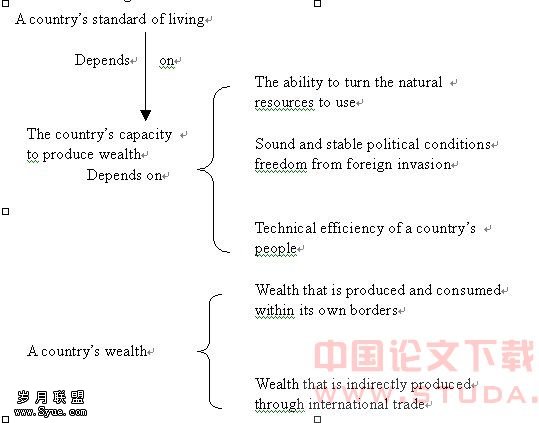
That is the organized structure of the passage. How to conclude it? You’ve known that this passage is an exposition. First, activate your schema of exposition. What is exposition? Exposition, one of the basic forms of communication, means explanation or putting across some information or ideas. Its primary function is not to tell a story or relate a happening, although it often uses narration or description as one of its associated techniques. Nor is its primary function to create vivid pictures for the reader. Rather, it explains something logically, and shows relationships. So we could conclude that the following paragraphs (except paragraph one) are going to explain the capacity to produce wealth. Second, catch the transitional words. The transitional words in the first paragraph are: first and foremost; in the second paragraph: to a great extent upon; in the third paragraph: next to, another; in the last paragraph: not only, but also. From these transitional words, it’s easy to master the structure of this passage. And it’s also very easy to do the questions below:
69. The standard of living in a country is determined by ___.
A. its goods and services
B. the type of wealth produced
C. how well it can create wealth
D. what an ordinary person can share
70. A country’s capacity to produce wealth depends on all the factors EXCEPT ___.
A. people’s share of its goods
B. political and social stability
C. qualities of its workers
D. use of natural resources
71. According to the passage, ___ play an equally important rule in determining a country’s standard of living.
A. farm products
B. industrial .goods
C. foodstuffs
D. export and import
3.2 Linguistic schema
Linguistic schema means the language knowledge structure of a reader, which mainly includes lexical, syntactic and semantic knowledge. Linguistic schema is the predetermination of reading. Many experiment show that the richness of language knowledge, especially the quantity of vocabulary has the greatest relation to the result of reading.
Vocabulary development is essential for reading. And a good vocabulary is usually the result of a systematic, planned program designed with the individual in mind. For your reading skills to be up to par, you must have good command of words. The most important part of vocabulary is meaning. There are two ways to predict the meaning of words.
3.2.1 Using context clues
Using context clues in word recognition means figuring out the meaning of a word based on clues in the surrounding context. Most authors realize that some readers have problems with difficult words and deliberately put in clues that will enable the reader not only to recognize the words but also to get the meaning of the words. Authors also write in such a way as to prevent misreading due to personal interpretation. A word could have a different meaning to different people with differing backgrounds of knowledge and experience. The author will put a clue in the writing to indicate to the reader the interpretation that is intended.
Context clues will be easier if you are familiar with some of the kinds of clues often found in sentences. Followings are some common kinds of clues with examples and an explanation of each.
“(i). Restatement
1 Animosity, a feeling of strong dislike, developed among the workers when some refused to join the union.
2 Polygamy, the practice of having two or more mates, is unlawful in the United States.
A restatement is merely stating the word in another way, usually in simpler terms. A restatement is usually set off by commas. In the first example animosity means a feeling of strong dislike. In the second example polygamy is the practice of having two or more mates.
(ii). Synonyms
1 The old man was cantankerous. He was ill-tempered, mean, and extremely quarrelsome.
2 At first I was doubtful that I could do the job. After one successful week, however, I am much less dubious.
A synonym is one of two or more words that have the same or similar meaning. When an author uses a difficult word, he often will also use a more familiar word to make it easy to understand. In the first example cantankerous means ill-tempered, mean, and quarrelsome. The second example uses the word dubious which means doubtful.
(iii). Antonyms
1 The sea lion is a cumbersome animal on land, but in the water it is one of the most graceful.
2 In contrast to their enjoyment of their country home, the Jones family found it difficult to adjust to urban life.
An antonym is a word of opposite meaning. In the first example above the ‘but’ signals that an opposite is being used. Therefore, cumbersome is the opposite of graceful and means clumsy. Example 2 uses ‘in contrast to’ in order to indicate that urban is the opposite of country.
(iv). Definitions
1 A disease that can be spread from one person to another is said to be contagious.
2 An incoherent statement is a statement that is not logically connected.
It is not unusual for an author to put in a statement that clearly defines a difficult word. In the examples above, contagious means spreading from one person to another person and incoherent means not logically connected.
(v). Explanation
1 We should be skeptical of get-rich-quick plans because financial success usually requires long hours and hard work.
2 Marilyn is a versatile musician. Not only does she sing and play the piano, but she plays many other instruments as well.
As an aid to the reader, difficult words are sometimes explained to make the meaning clearer. The explanation might be found in the same sentence with the difficult word, in the sentence before, or in the sentence following the word. In the first example above, skeptical is explained in the same sentence and is signaled by the word ‘because’. As used in the sentence, skeptical means doubtful or questioning. In the second sentence, versatile is explained by additional information in the sentence that follows. The sample sentence, then, means that Marilyn is competent in many aspects of music.
(vi). Relationships
1 The students were jubilant when they learned that their school had placed first in the competition.
2 Each time you drive in excess of the speed limit, especially when traffic is heavy, you jeopardize not only your own life but the lives of others as well.
This type of clue is less concrete and requires more thinking on the part of the reader. Here, you must see a relationship between the difficult word and something the author has stated. This relationship must be seen with little explanation and few clues. In example 1 think about how student would feel if they placed first in a competition. Some synonyms of jubilant would be joyful, rejoicing, or elated. Likewise, in example 2 you see the relationship between excessive speed and a danger to your life. Thus, jeopardize means endanger.” [8]
3.2.1. Word parts
Words are often made up of a prefix, a combining form (or root word), and a suffix. “Take for example the word incredible.
Prefix = in =not
Combining form =cred =believe
Suffix =ible =able
If you put the meaning of the parts together and rearrange them to make sense, you have ‘not able to believe’.” [9]
(i). Prefixes
“A prefix is a word part that is added to the beginning of a word (called the base word) or a word part such as a combining form or root word. For example, the word prefix is made up of the prefix pre (before, in front) and the root word fix (to attach) and prefix means ‘to attach before or in front’. A prefix has a meaning and that meaning is added to the meaning of the base word, root word, or combining form to which it is attached. The prefix dis means ‘not’. When dis is added to the base word similar, the word becomes dissimilar and means ‘not similar’” [10]
There are other prefixes,
anti = against bi =two, twice
circum =around ex =from, beyond
extra =outside, beyond inter =between, among
mis =wrong, bad re =back, again
tri =three ultra =beyond, excessive
(ii). Combining Forms
“Root words and combining forms are word parts that are very useful to know because they can help you learn whole groups of words. For example:
somn = sleep
insomnia = inability to sleep
somnolent = sleepy
somnambulist = one who sleep walks
As you can see from the above example the root word or combining form can be at the beginning or in the middle of the word. It can also be at the end of a word. For example:
vene =come
convene =come together
You don’t need to know whether a word part is a root word or a combining form. What is important is to realize that knowing the meanings of root words and combining forms will enable you to unlock the meanings of whole groups of words. For example, knowing that cred means ‘belief or trust’ will help you figure out the following words:
credit creditor creditable creditability
credible incredible credibility incredibility
credulity incredulity credulous incredulous
credentials credence creed credo” [11]
There are other root words:
alpha = beginning div =separate
audio =hear fix =to place
bio =life graph =write
cent =hundred neuro =nerves
demo =people tele =far off
etc.
(iii). Suffixes
A suffix is a word part that comes at the end of a word. A suffix can modify the meaning of a word and/or change the part of speech of the word. For example, one meaning of employ is “to engage the service of, hire” and is a verb. Adding the suffix ee or er to employ modifies the meaning to “someone who is employed” or “someone who employs” and results in the words employee and employer, which are nouns. Another example: changeable. Take the suffix off, the word becomes: change able
The word must mean something like “able to change”
There are other suffixes:
ation: =act, condition est: =most
ive =nature of ly =in a certain manner
meter: =measure ness =quality of , state of
ous = full of tude = state, condition
etc.
3.3 Content Schema
Content schema means a reader’s background knowledge and past personal experience, and provides the comparative base for the reader. Content schema can be divided into three parts. First is the knowledge of subject-matter, such as laws, economy, literature, chemistry, medicine, etc. Second is the knowledge of the world, which is the knowledge that people know how the matters around them work. For example, “The car stopped at the red traffic light”. People know that because the knowledge of the world tells them. A chauffeur drives a car, and he knows that red light is the signal of stopping driving. The last one is the cultural knowledge, which means the cultures that people in the same certain society have. For example, Chinese people usually ask “Do you have dinner?” when they meet in the evening. That is the Chinese culture.
So when we read a passage, we aim at arousing and cultivating our previous knowledge in order that we can understand articles completely. And if we lack for some content schema, or the capability of activating the schema, even we have certain language level; we still couldn't set up the hypothesis to do the reading comprehension fluently. For example, “ ‘The eagle always flew on Friday’, when reader look at this sentence, he would connect the sentence in above paragraphs ‘it was on a Thursday, the day before the Negro payday’, and the sentence in later paragraphs ‘The teacher was asking each student how much (many) his father would….’ From the two sentences we could conclude that this sentence is related to money, rather than the eagle. Now activate your background knowledge: ‘eagle’ is American’s national symbol, and most American paper currency and coins are printed with the design of eagle. So eagle here means American money. The sentence could be ‘Payments were always given on Friday.’” [12]
Let’s look at another example: “Business had been slow since the oil crisis. Nobody seemed to want anything really elegant anymore. Suddenly the door opened and a well dressed man entered the show room floor. John put on his friendliest and most sincere expression and walked toward the man.” [13]
The question is: Please explain concretely the place that things happened.
This passage tells us that because of the oil crisis, cars selling business were not good. Suddenly a customer came in. The seller John welcomed with great enthusiasm, attempting to do this business. So this thing happened in a shop selling cars. From the first sentence, the business that would be influenced by oil is cars and gas station. And “elegant” could eliminate gas station. When we see the “show room floor”, we could know that the place must be in the car-selling shop. But as a Chinese student, because cars are not the necessary of life and the influence of oil crisis is small, and “show room” means exhibition room from the literal meaning. So Chinese students usually couldn’t understand the content of the text. That is the cultural differences.
So if we don’t activate our background knowledge and schema, we couldn’t understand a reading passage correctly.
i. Prediction is a good way to activate your content schema.
Predicting in pre-reading refers to thinking in advance about the topic of what to be read. It is very crucial in the reading process in two aspects. First, by predicting the topic, reader’s existing schema, which is referred to as content schema, can be activated and thereby facilitate reading comprehension in the reading phase. Second, it is generally agreed that the main difference between a classroom reading text and a real-life reading text is that the former requires a reading purpose in the classroom. Learners’ predicting before reading not only serves as a purpose for reading the text, but also draws their attention in the reading process. It has been assumed in many theories that attention and purpose are absolutely bound up with reading, determine whether it happens at all, and what form it takes if it does.
When we read texts in our own language, we frequently have a good idea of the content before we actually read. Book covers give us a hint of what’s in the book, photographs and headlines hint at what articles are about before we read a single word.
“The moment we get this hint----the book cover, the headline, the word-processed page----our brain starts predicting what we are going to read. Expectations are set up and the active process of reading is ready to begin.”[14] But it is very important to ensure the learners that the aim of predicting is to activate their schematic background knowledge and prepare their mind for reading whether the prediction is right or wrong.
Try to guess, “a reader faces an article naming ‘Robots’. If he wants to predict before reading according to the title, he should present the questions in his mind, and then predict the content that the article may refer to. That would be a great help for understanding the article. The content referred may be:
1 What is a robot?
2 Is there any difference between a robot and an automaton?
3 What can robots be used for?
4 Can they ever completely replace human beings for some jobs? Which ones?
Of course, different readers varies from their language level, cognitive capability and life experience, the prediction questions would be different, too. But the most important point is that if readers think with questions in the process of reading, their thoughts usually in the active station, they would tune their thoughts according to the content of passage consciously or unconsciously, and continue reasoning and estimation logically. So they read faster, identify the topic sentence and key words and the author’s intention better, until the whole passage is perfectly understood.” [15]
Prediction could also be used in the process of reading besides pre-reading. Let’s look at this sentence: To rescue my mother or my wife when they both fell into the water, that is a Hobson’s choice. What does “Hobson’s choice” mean? How to use the skill of prediction to infer its meaning? From the first part of the sentence, we know that the man is in an embarrassing situation, he couldn’t decide who to be rescued. So actually “Hobson’s choice” is to have no choice at all.
Prediction could even be used in the following condition. The first sentence of each paragraph usually expresses the general idea of a whole paragraph. We call it “topic sentence”, and other sentences usually are the explanation, complement of the topic sentence. So when we find the topic sentence, we could predict the content of the meaning of the paragraph.
ii. Association is also an important part in reading.
Look at the example of Hobson’s choice. If you have something idea about “Hobson’ choice”, you should memorize the origin of the phrase to predict the meaning. The Hobson owned a stable of horses in Cambridge, England. Mr. Hobson often rented the horses to the students at Cambridge University. But he did not really trust them to take good care of the horses, so he had a rule that prevented the students from riding his best horses. They could take the horse that was nearest the stable door or they could not take any horse at all. Thus a Hobson’s choice was really no choice.
Now we will use the two skills to comprehend the following example of reading comprehension, TEM 4, 2003, TEXT B.
“There are superstitions attached to numbers; even those ancient Greeks believed that all numbers and their multiples had some mystical significance.
Those numbers between 1 and 13 were in particular to have a powerful influence over the affairs of men.
Another belief involving the number three has it that it is unlucky to light three cigarettes from the one match. If this happens, the bad luck that goes with the deed falls upon the person whose cigarette was the last to be lit. The ill-omen linked to the lighting of three things from one match or candle goes back to at least the 17th century and probably earlier. It was believed that three candles alight at the same time would be sure to bring bad luck; one, two, or four, were permissible, but never just three.
Seven was another significant number, usually regarded as a bringer of good luck. The ancient astrologers believed that the universe was governed by seven planets; students of Shakespeare will recall that the life of man was divided into seven ages. Seven horseshoes nailed to a house will protect it from all evil.
Nine is usually thought of as a lucky number because it is the product of three times three. It was much used by the Anglo Saxons in their charms for healing.
Another belief was that great changes occurred every 7th and 9th of a man’s life. Consequently, the age of 63(the product of nine and seven) was thought to be a very perilous time for him. If he survived his 63rd year he might hope to live to a ripe old age.
Thirteen, as we well know, is regarded with great awe and fear.
The common belief is that this derives from the fact that there were 13 as people at Christ’s Last Supper. This being the eve of his betrayal, it is not difficult to understand the significance given to the number by the early Christians.
In more modern times 13 is an especially unlucky number of a dinner party, for example. Hotels will avoid numbering a floor the 13th; the progression is from 12 to 14, and no room is given the number 13. Many home owners will use 12 1/2 instead of 13 their house number.
Yet oddly enough, to be born on the 13th of the month is not regarded with any fear at all, which just shows how irrational we are in our superstitious beliefs. [16]
From the first two paragraphs we know that this passage tells something superstitions about number from 1 to 13. This subject has great relation with our daily life. So naturally we have our own ideas about it. Now activate our schema, arouse our background knowledge, try to associate the related knowledge. In China, we could usually see the number of car with “8”, or the price with number “8”, because number “8” means earning money. But there is another number people usually avoid using: number “4”, which means unlucky, death. Number 6 is a lucky number, too. It means that going through things successfully. In western country, people usually don't like number 13, because it’s the symbol of Satan.
Now with the background knowledge we go through the passage, and circle the number it has referred. We know that the first sentence of each paragraph usually is the topic sentence in that paragraph. We could use this method. And with the circles we did, we could easily find that the topic sentences. For example, look at the first sentence in paragraph four: “Seven was another significant number, usually regarded as a bringer of good luck.” The following sentences explain the reason.
In the process of reading, students usually use one schema to comprehend one text, but actually one text could be understood by using the three schemas together. As for the article above, students could also use formal schema to comprehend it. This article uses the structure of general-part.
General: Paragraph 1-2 The introduction of number’s influence
Paragraph 3 The meanings of number 3
Paragraph 4 The meanings of number 7
Part: Paragraph 5 The meanings of number 9
Paragraph 6 The meanings of number 63
(the product of 7 and 9)
Paragraph 7-10 The meanings of number 13
4. The Significance of Activating Schemas to Understand Reading
We’ve known that reading is an incredibly active occupation. To do it successfully, we have to understand what the words mean, see the pictures the words are painting, understand the arguments, and work out if we agree with them. So reading is a two-way process involving communications, or interaction between the complicated contents by a writer and the reader’s previous knowledge. “Critical reading (which is a form of critical thinking) is an active, creative skill that requires you to question, compare, and evaluate. Critical-reading skills are necessary in order to determine the value of reading material, to detect faulty logic and information, to separate facts from opinions, and then to determine if you need to accept or reject the information.”[17] How to be a critical reader?
4.1 “Considering the credibility of the author” [18]
Because a writer’s identity partially determines what he or she will say, critical readers and thinkers always ask questions about the writer. Who is the writer? How do I know he or she is an expert on the subject? Can I be reasonably comfortable that the facts the writer provides are true? The only way to be sure you are receiving accurate information is to select books and articles by qualified authors. Often there is information about the author in front of the book.
4.2 “Distinguishing between fact and opinion” [19]
A fact is something that has actually happened. It is true and can be proved. An opinion is a belief that is based on a personal evaluation. Critical reading and thinking hinges on knowing and recognizing this difference. Critical thinkers don’t simply accept opinions. When they come across an opinion, they look for logical support for that opinion and then decide whether or not to accept it.
4.3 “Evaluate the evidence” [20]
Facts don’t need supporting evidence, but opinions do. When you come across an opinion, your task as a critical thinker is to see first of all if there is any evidence, and then to evaluate the strength of that evidence. Opinions supported by opinions aren’t very effective because there’s no reason for a reader to accept the author’s opinion without any evidence.
4.4 “Look out for “swayers”-----subtly influential language” [21]
Authors choose words that convey the message they intend the reader to receive. By carefully choosing their words, writers can often influence of “sway” you in a certain direction before you realize it. For example, if you were reading an article that was designed to make you want to join the Armed Forces, the author would use such words as patriotism, liberty, free, freedom, etc.
4.5 “Reject faulty reasoning” [22]
The faulty reasoning is generally to be considered the emotional appeal rather than logical reasoning. Writers often fall back on emotional (faulty) reasoning when they lack logical support for their argument. They may also try to pass off what looks like logical reasoning but in reality is not.
As a college student, you need to be able to assess what you read as well as understand it. Just remember that you are not an empty mold into which a writer can pour meaning. Instead, you are a unique reader who brings unique experiences and attitudes with you, and you shape your own meaning by joining what you know and feel with what the writer tells you. You put together your own interpretation when you read someone else’s writing, just as you put together an interpretation of events when you write something yourself. Critical thinking skills enable you to make wise judgments about what you read. By considering the five suggestions above, you can determine whether you should accept ideas and opinions or reject them.
5. Conclusion
English reading as an absolutely necessary subject in students’ study requires students to master the reading skills. Schema Theory is a theory that students could use to comprehend the English reading. Students usually use the three schemas (formal schema, linguistic schema and content schema) unconsciously to understand an English text. After understanding the text, the last step for students is to be the critical thinkers. Then the work of comprehending a text is perfectly finished.
And teachers could consider Schema Theory as an English study strategy and combine them into the teaching process to help students improve their reading ability, let them complete the reading comprehension easily and correctly.
Biography (References)
[1] http://chd.gmu.edu/immersion/kkowledgebase/strategies/cognitivism/SchemaTheory.htm
[2] 张必隐, 阅读心[M], 北京师范大学出版社, 1992, P240
[3] 孙鸣, 学习与教学设计[M], 上海出版社, 2004, P163
[4] 李观仪, 新编英语教程学生用书第4册[Z], 上海外语教育出版社,2000, P61
[5] Elizabeth Chesla, Reading Skills for College Students [M], Prentice Hall, Inc., 1998, P54
[6] 刘涤非, 谈大学英语阅读提高方法[J], 吉林省管理干部学院学报.2004. (12): P66
[7] http://www.dafuxi.com/study/shiti/shiti/zhuanyeyingyushitishijuan/7322.htm
[8] Ophelia H. Hancock, Reading Skills for College Students [M], Prentice Hall, Inc., 1991, P26-28
[9] Diane W.Creel, Essential Skills for Reading College Texts [M], Wadsworth, Inc, 1989, P36
[10] 同[9],P37-38
[11] 同[9],P46
[12] 傅静, 图式理论与英语阅读教学[J],安阳师范学院学报, 2004.(6), P95
[13] 同2, P249
[14] Jeremy Harmer, How to Teach English [M], Foreign Language Teaching and Research Press, 1983, P71
[15] 陈伟平, 预示角度与英语阅读[J], 广西社会,2004.(10), P188
[16] http://info.sohu2000.com/info_show/info_show_309.html
[17] 同[8], P153
[18] 同[5], P137
[19] 同[5], P137
[20] 同[5], P137
[21] 同[5], P137
[22] 同[5], P137
